Analyzing Urban Residents’ Appraisal of Ridepooling Service Attributes with Conjoint Analysis
Abstract
1. Introduction
1.1. The Benefits of Shared Mobility Services for Cities
1.2. Travelers’ Requirements for Ridepooling Services
2. Materials and Methods
2.1. Choice-Based Conjoint Analysis
2.2. Definition of Attributes and Levels
- Time of booking describes the minimal number of minutes required to book a ride beforehand.
- Walking distance describes the distance in meters to reach the nearest pick-up point.
- Shift of departure defines the possible shift of the pick-up time caused by the previous access of other passengers.
- Travel time describes the in-vehicle time that is influenced by the detours caused by the access and egress of other travelers.
- Information provision describes the quantity of information that is given to the travelers.
- Fare is defined as the price in euro for a single trip.
2.3. Experimental Choice Design
2.4. Sample Description
2.5. Data Analysis
3. Results
3.1. Results for the Total Sample
3.2. Results Comparing Previous Ridepooling Experience
3.3. Results Comparing Age Groups
3.4. Results Comparing Trip Purpose
4. Discussion
4.1. Summary and Interpretation of Results
4.2. Limitations and Further Research Needs
4.3. Recommendations for Policy, Transport Authorities, and City Planning
- Walking distance to the pick-up points of the ridepooling service should be as short as possible, especially in city districts with a high average age. If possible, a door-to-door service should be offered. In contrast, in districts with a high share of students or low-income earners, the density of pick-up points could be lower to allow lower fares.
- In order to avoid notable shifts of departure, transport agencies should aim to provide a high availability of vehicles, especially in areas with high demand, like the city center.
- A large shift of departure should be avoided for trip purposes with a fixed appointment like a doctor’s visit or a train departure to ensure connection.
- To guarantee seamless interchanges between ridepooling systems and means of public transport, these connections should be taken into consideration for routing and should be prioritized.
- The fare should be set as low as possible to position public transport as an eco-friendly competitor for motorized individual transport. If possible, the pricing scheme of public ridepooling services should be integrated into the local tariff of public transport to facilitate intermodal trip chains [51].
- It should be possible to use monthly tickets and student tickets for the ridepooling system. In this way, the integration of the ridepooling service into fixed-schedule transport could be facilitated and public transport could be complemented.
- Avoid excessive travel times by limiting the maximum detour to an acceptable, still-to-be-defined level to reach a reasonable fit that describes a state in which the benefits of sharing the ride are greater than the costs of the detour [53].
5. Conclusions
Author Contributions
Funding
Conflicts of Interest
References
- Cornet, A.; Mohr, D.; Weig, F.; Zerlin, B.; Hein, A.-P. Mobility of the future. In Opportunities for Automotive OEMs; Research Report; McKinsey & Company: New York, NY, USA, 2012. [Google Scholar]
- Han, Y.; Li, W.; Wei, S.; Zhang, T. Research on Passenger’s Travel Mode Choice Behavior Waiting at Bus Station Based on SEM-Logit Integration Model. Sustainability 2018, 10, 1996. [Google Scholar] [CrossRef]
- Henao, A. Impacts of Ridesourcing -LYFT and UBER- on Transportation including VMT, Mode Replacement, Parking and Travel Behavior. Ph.D. Thesis, University of Colorado, Denver, CO, USA, 2017. [Google Scholar]
- Babar, Y.; Burtch, G. Examining the Impact of Ridehailing Services on Public Transit Use. Available online: https://papers.ssrn.com/sol3/papers.cfm?abstract_id=3042805 (accessed on 18 July 2018).
- Tirachini, A.; Gomez-Lobo, A. Does Ridesourcing Increase or Decrease Vehicle Kilometers Traveled (VKT)? A Simulation Approach for the Case of Santiago, Chile; Working Paper; Econ Uchile Publications: Santiago, Chile, 2017. [Google Scholar]
- Shaheen, S.; Cohen, A. Shared Mobility Policy Briefs: Definitions, Impacts, and Recommendations; UC Berkeley ITS Reports No. UC-ITS-RR-2017-11; ITS Berkeley: Berkeley, CA, USA, 2018. [Google Scholar]
- Via Transportation. Welcome to Via. We Ride Together. Homepage Via Transportation. Available online: https://ridewithvia.com/ (accessed on 29 November 2017).
- Alonso-Mora, J.; Samaranayake, S.; Wallar, A.; Frazzoli, E.; Rus, D. On-demand high-capacity ride-sharing via dynamic trip-vehicle assignment. Proc. Natl. Acad. Sci. USA 2017, 114, 462–467. [Google Scholar] [CrossRef] [PubMed]
- Feigon, S.; Murphy, C. Shared Mobility and the Transformation of Public Transit; TCRP Research Report 188; The National Academy Press: Washington, DC, USA, 2016. [Google Scholar] [CrossRef]
- ITF—International Transport Forum. Shared Mobility. Innovation for Liveable Cities; Corporate Partnership Board Report; OECD: Paris, France, 2016. [Google Scholar]
- Martinez, L.M.; Correia, G.H.A.; Viegas, J.M. An agent-based simulation model to assess the impacts of introducing a shared-taxi system: An application to Lisbon (Portugal). J. Adv. Transp. 2015, 49, 475–495. [Google Scholar] [CrossRef]
- Pakusch, C.; Stevens, G.; Boden, A.; Bossauer, P. Unintended Effects of Autonomous Driving: A Study on Mobility Preferences in the Future. Sustainability 2018, 10, 2404. [Google Scholar] [CrossRef]
- Friedrich, M.; Hartl, M. MEGAFON—Modellergebnisse geteilter autonomer Fahrzeugflotten des oeffentlichen Nahverkehrs; Final Report; University of Stuttgart: Stuttgart, Germany, 2016. [Google Scholar]
- Fagnant, D.J.; Kockelman, K.M. The travel and environmental implications of shared autonomous vehicles, using agent-based model scenarios. Transp. Res. Part C Emerg. Technol. 2014, 40, 1–13. [Google Scholar] [CrossRef]
- Brandies, A.; König, A.; Viergutz, K.; Fraedrich, E.; Gebhardt, L.; Ulmer, F.; Sippel, T.; Dotzauer, M. Transdisziplinäre Mobilitätsforschung unter Verwendung von Reallaboren: Integration von Stakeholderbedürfnissen und -Anforderungen in die Entwicklung von Systemen Bedarfsorientiert und Vollautomatisiert Fahrender Quartiersbusse; Paper presented at 18; Braunschweiger Symposium AAET 2017; Automatisiertes und vernetztes Fahren: Braunschweig, Germany, 2017. [Google Scholar]
- Rogers, E.M. Diffusion of Innovations, 5th ed.; Free Press: New York, NY, USA, 2003; ISBN 0743222091. [Google Scholar]
- Beirão, G.; Cabral, J.A.S. Understanding attitudes towards public transportation and private car: A qualitative study. Transp. Policy 2007, 14, 478–489. [Google Scholar] [CrossRef]
- Bourgeat, P. A revealed/stated preference approach to bus service configuration. Transp. Res. Procedia 2015, 6, 411–423. [Google Scholar] [CrossRef]
- Jianrong, L.; Wei, D.; Bing, Z. Conjoint analysis based transit service quality research. J. Transp. Syst. Eng. Inf. Technol. 2011, 11, 97–102. [Google Scholar] [CrossRef]
- De Oña, J.; De Oña, R.; Eboli, L.; Mazzulla, G. Perceived service quality in bus transit service: A structural equation approach. Transp. Policy 2013, 29, 219–226. [Google Scholar] [CrossRef]
- Hensher, D.A. Stated preference analysis of travel choices: The state of practice. Transportation 1994, 21, 107–133. [Google Scholar] [CrossRef]
- König, A.; Bonus, T.; Grippenkoven, J. Modelling travelers’ appraisal of ridepooling’s service characteristics. Transp. Policy 2018. in review. [Google Scholar]
- Brake, J.; Mulley, C.; Nelson, J.D.; Wright, S. Key lessons learned from recent experience with flexible transport services. Transp. Policy 2007, 14, 458–466. [Google Scholar] [CrossRef]
- Finn, B.; Ferrari, A.; Sassoli, P. Goals, requirements and needs of users. In Demand Responsive Transport Services. Towards the Flexible Mobility Agency; Ambrosino, G., Nelson, J.D., Romanazzo, M., Eds.; Enea: Rome, Italy, 2004; pp. 33–54. ISBN 88-8286-043-4. [Google Scholar]
- KFH Group. Guidebook for Measuring, Assessing, and Improving Performance of Demand-Response Transportation; Transit Cooperative Research Program Reports; Transportation Research Board: Washington, DC, USA, 2008; Volume 124. [Google Scholar]
- Kahrs, C. Erlösorientierte Produktgestaltung von Anrufbussystemen unter Anwendung der Conjoint-Analyse. In Verkehrssystem- und Mobilitätsmanagement im Ländlichen Raum; Kagermeier, A., Ed.; Studien zur Mobilitäts- und Verkehrsforschung: Mannheim, Germany, 2004; pp. 391–404. [Google Scholar]
- Takeuchi, R.; Nakamura, F.; Okura, I.; Hiraishi, H. Feasibility study on demand responsive transport systems. J. East. Asia Soc. Transp. Stud. 2003, 5, 388–397. [Google Scholar]
- König, A.; Grippenkoven, J. The Actual Demand behind Demand-Responsive Transport: Applying the Unified Theory of Acceptance and Use of Technology to Explain Usage Intentions of Demand-Responsive Bus Services. Transp. Geography 2018. in review. [Google Scholar]
- Nelson, J.D.; Phonphitakchai, T. An evaluation of the user characteristics of an open access DRT service. Res. Transp. Econ. 2012, 34, 54–65. [Google Scholar] [CrossRef]
- Specht, M. Raumbezogene Marktanalyse innovativer und geteilter Mobilitätsangebote. Bachelor’s Thesis, Ruhr-Universität Bochum, Bochum, Germany, 2018. [Google Scholar]
- Louviere, J.J.; Hensher, D.A.; Swait, J. Stated Choice Methods: Analysis and Applications in Marketing, Transportation and Environmental Valuation; Cambridge University Press: Cambridge, UK, 2000; ISBN 0521782759. [Google Scholar]
- Hair, J.F.; Black, W.; Babin, B.J.; Anderson, R.A. Conjoint Analysis. In Multivariate Data Analysis, 7th ed.; Pearson: London, UK, 2010; pp. 342–413. ISBN 0138132631. [Google Scholar]
- Backhaus, K.; Erichson, B.; Weiber, R. Auswahlbasierte Conjoint- Analyse. In Fortgeschrittene Multivariate Analysemethoden; Backhaus, K., Erichson, B., Weiber, R., Eds.; Springer Gabler: Berlin/Heidelberg, Germany, 2015; pp. 175–292. ISBN 978-3-662-46087-0. [Google Scholar]
- Cohen, S.H. Perfect Union: CBCA Marries the Best of Conjoint and Discrete Choice Models. Mark. Res. 1997, 9, 12–17. [Google Scholar]
- Bahamonde-Birke, F.J.; Navarro, I.; de Dios Ortúzar, J. If you choose to not decide, you still have made a choice. J. Choice Model. 2017, 22, 13–23. [Google Scholar] [CrossRef]
- Rao, V.R. Choice Based Conjoint Studies: Design and Analysis. In Applied Conjoint Analysis; Rao, V.R., Ed.; Springer: Berlin/Heidelberg, Germany, 2014; pp. 127–183. ISBN 978-3-540-87753-0. [Google Scholar]
- Kløjgaard, M.E.; Bech, M.; Søgaard, R. Designing a stated choice experiment: The value of a qualitative process. J. Choice Model. 2012, 5, 1–18. [Google Scholar] [CrossRef]
- Morrison, M.; Bennett, J.W.; Blamey, R.K. Designing Choice Modelling Surveys Using Focus Groups: Results from the Macquarie Marshes and Gwydir Wetlands Case Studies; Choice Modelling Research Report No. 5; The University of New South Wales: Canberra, Australia, 1997. [Google Scholar]
- Omre, B. Formulating Attributes and Levels in Conjoint Analysis; Sawtooth Software Research Paper Series; Sawtooth Software: Sequim, WA, USA, 2012. [Google Scholar]
- Weiber, R.; Mühlhaus, D. Auswahl von Eigenschaften und Ausprägungen bei der Conjointanalyse. In Conjointanalyse; Baier, D., Brusch, M., Eds.; Springer: Berlin/Heidelberg, Germany, 2009; pp. 43–58. ISBN 978-3-642-00754-5. [Google Scholar]
- Aizaki, H.; Nishimura, K. Design and analysis of choice experiments using R: A brief introduction. Agric. Inf. Res. 2008, 17, 86–94. [Google Scholar] [CrossRef]
- Leiner, D.J. SoSci Survey (Version 2.5.00-i). Computer Software. Available online: https://www.soscisurvey.de (accessed on 24 March 2018).
- IBM Analytics. SPSS Software. Available online: https://www.ibm.com/analytics/de/de/technology/spss/ (accessed on 7 January 2018).
- Guadagni, P.M.; Little, J.D. A logit model of brand choice calibrated on scanner data. Mark. Sci. 1983, 2, 203–238. [Google Scholar] [CrossRef]
- Ben-Akiva, M.E.; Lerman, S.R. Discrete Choice Analysis: Theory and Application to Travel Demand; Series in Transportation Studies; MIT Press: Cambridge, UK, 1985; ISBN 9780262022170. [Google Scholar]
- Tyrinopoulos, Y.; Antoniou, C. Public transit user satisfaction: Variability and policy implications. Transp. Policy 2008, 15, 260–272. [Google Scholar] [CrossRef]
- Wilkowska, W.; Farrokhikhiavi, R.; Ziefle, M.; Vallèe, D. Mobility requirements for the use of carpooling among different user groups. In Proceedings of the 5th AHFE Conference, Krakow, Poland, 19–23 July 2014; pp. 129–140. [Google Scholar]
- Statistisches Bundesamt. Ergebnis 12211-0040. Bevölkerung (ab 15 Jahren): Deutschland, Jahre, Geschlecht. Altersgruppen, Allgemeine Schulausbildung. 2018. Available online: https://www-genesis.destatis.de/genesis/online/logon?sequenz=tabelleErgebnis&selectionname=12211-0040&transponieren=true (accessed on 27 July 2018).
- Tyrinopoulos, Y.; Antoniou, C. Factors affecting modal choice in urban mobility. Eur. Transp. Res. Rev. 2013, 5, 27–39. [Google Scholar] [CrossRef]
- De Jong, G.; Van de Riet, O. The driving factors of passenger transport. Eur. J. Transp. Infrastruct. Res. 2008, 8, 227–250. [Google Scholar]
- König, A.; Grippenkoven, J. From public mobility on demand to autonomous public mobility on demand -Learning from dial-a-ride services in Germany. In Logistik und Supply Chain Management; University of Bamberg Press: Bamberg, Germany, 2017; pp. 295–305. ISBN 978-3-86309-489-8. [Google Scholar]
- König, A.; Wegener, J.; Pelz, A.; Grippenkoven, J. Serious Games: A playful approach to reduce usage barriers of innovative public transport systems. In Proceedings of the 47th European Transport Conference, Barcelona, Spain, 24–26 May 2017; Available online: https://aetransport.org/en-gb/past-etc-papers/conference-papers-2017 (accessed on 18 July 2018).
- Geisberger, R.; Luxen, D.; Sanders, P.; Neubauer, S.; Volker, L. Fast detour computation for ride sharing. In Proceedings of the 10th Workshop on Algorithmic Approaches for Transportation Modeling, Optimization, and Systems (ATMOS’10), Liverpool, UK, 9 September 2010; pp. 88–99. [Google Scholar]
- Betzholz, D. Fremde Menschen Können sich Taxifahrten Künftig Teilen. Available online: https://www.welt.de/regionales/hamburg/article171206896/Fremde-Menschen-koennen-sich-Taxifahrten-kuenftig-teilen.html (accessed on 18 March 2018).
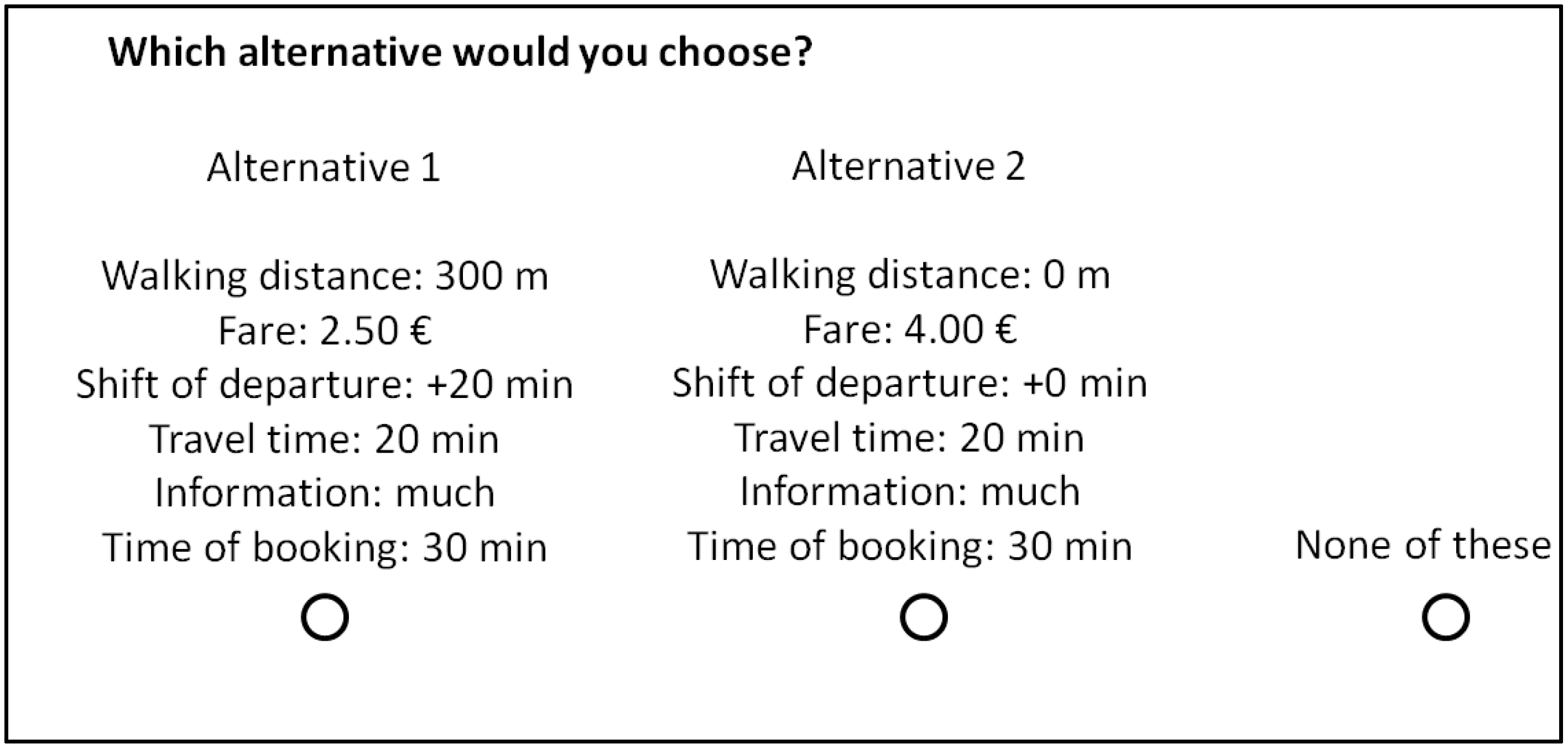
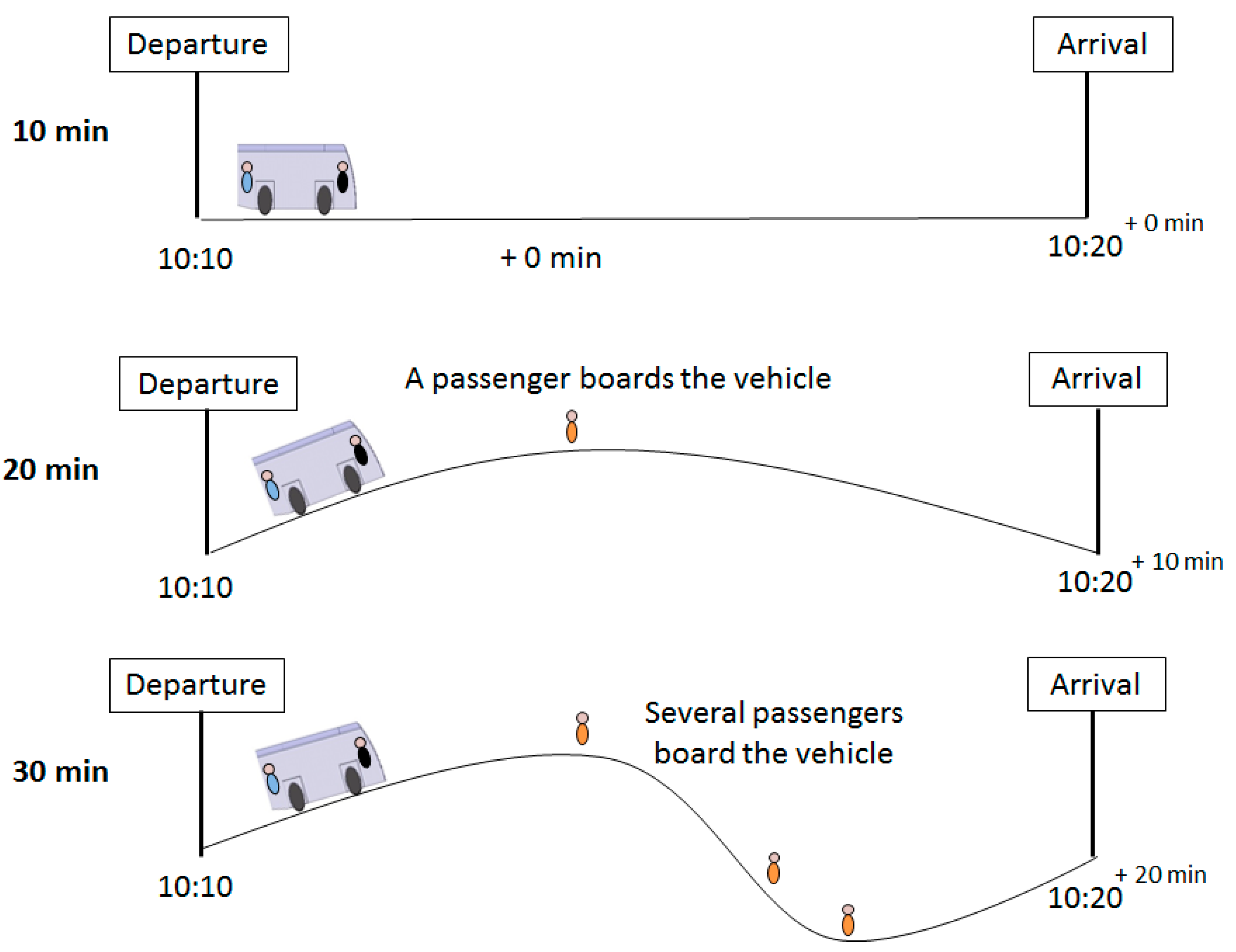
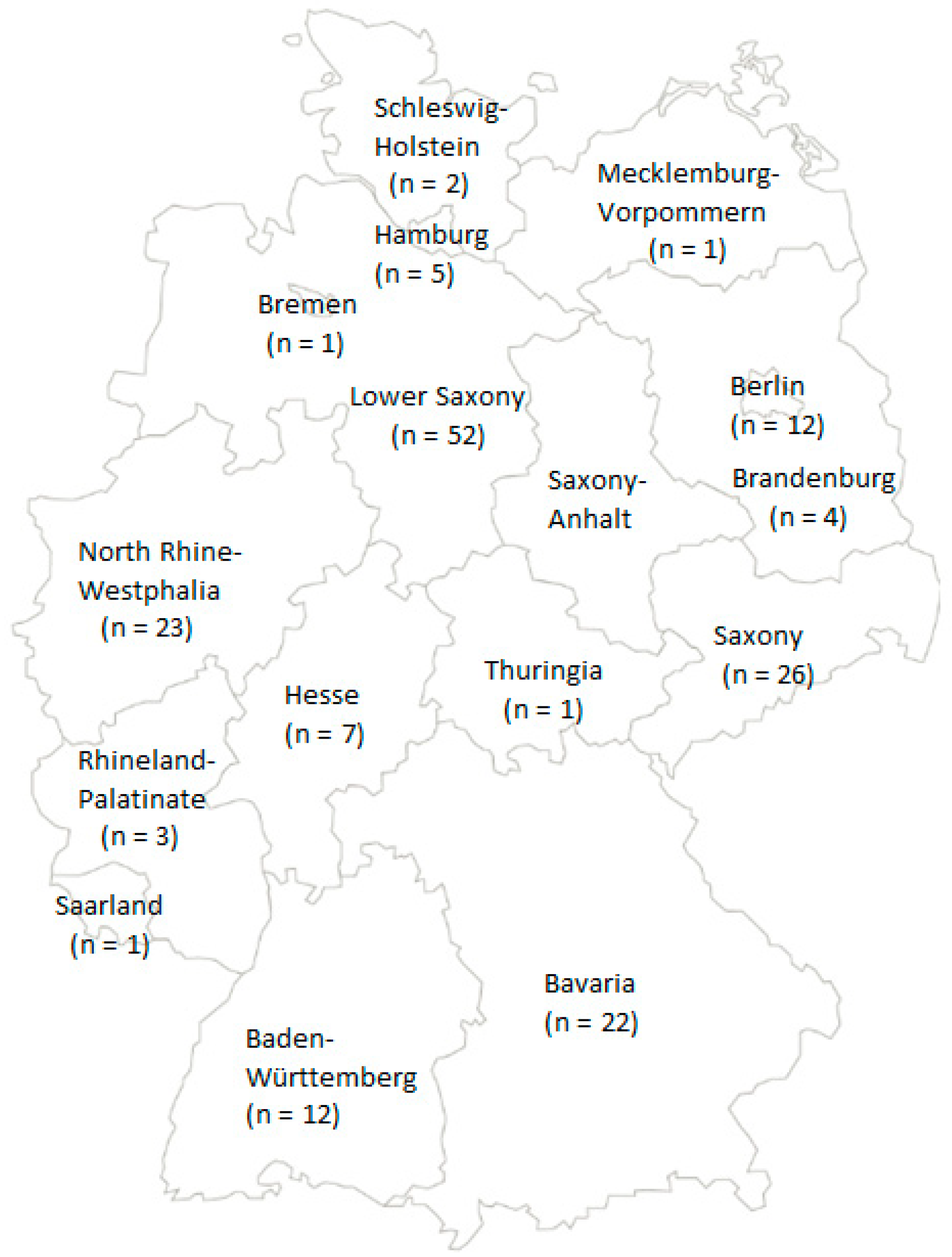
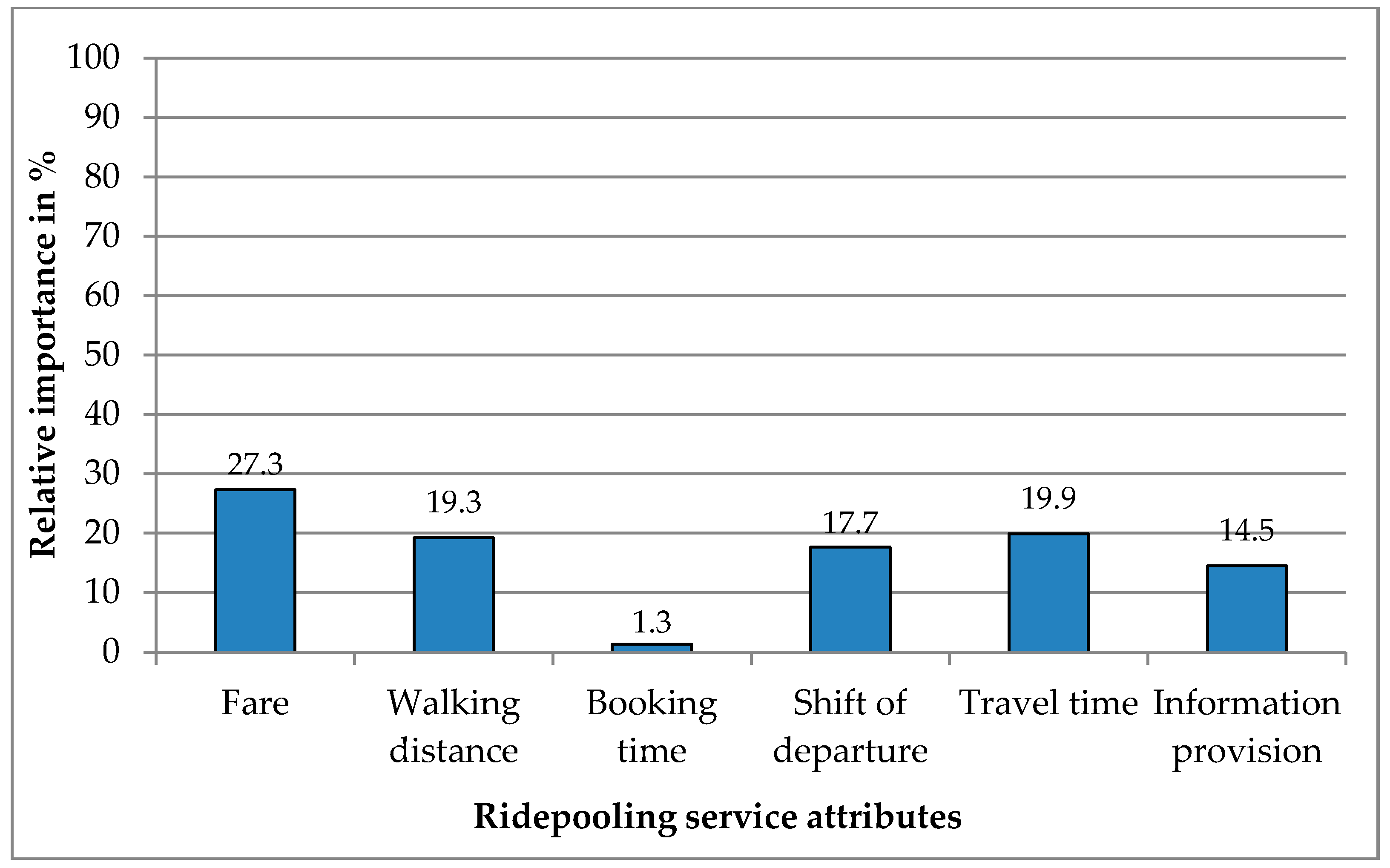
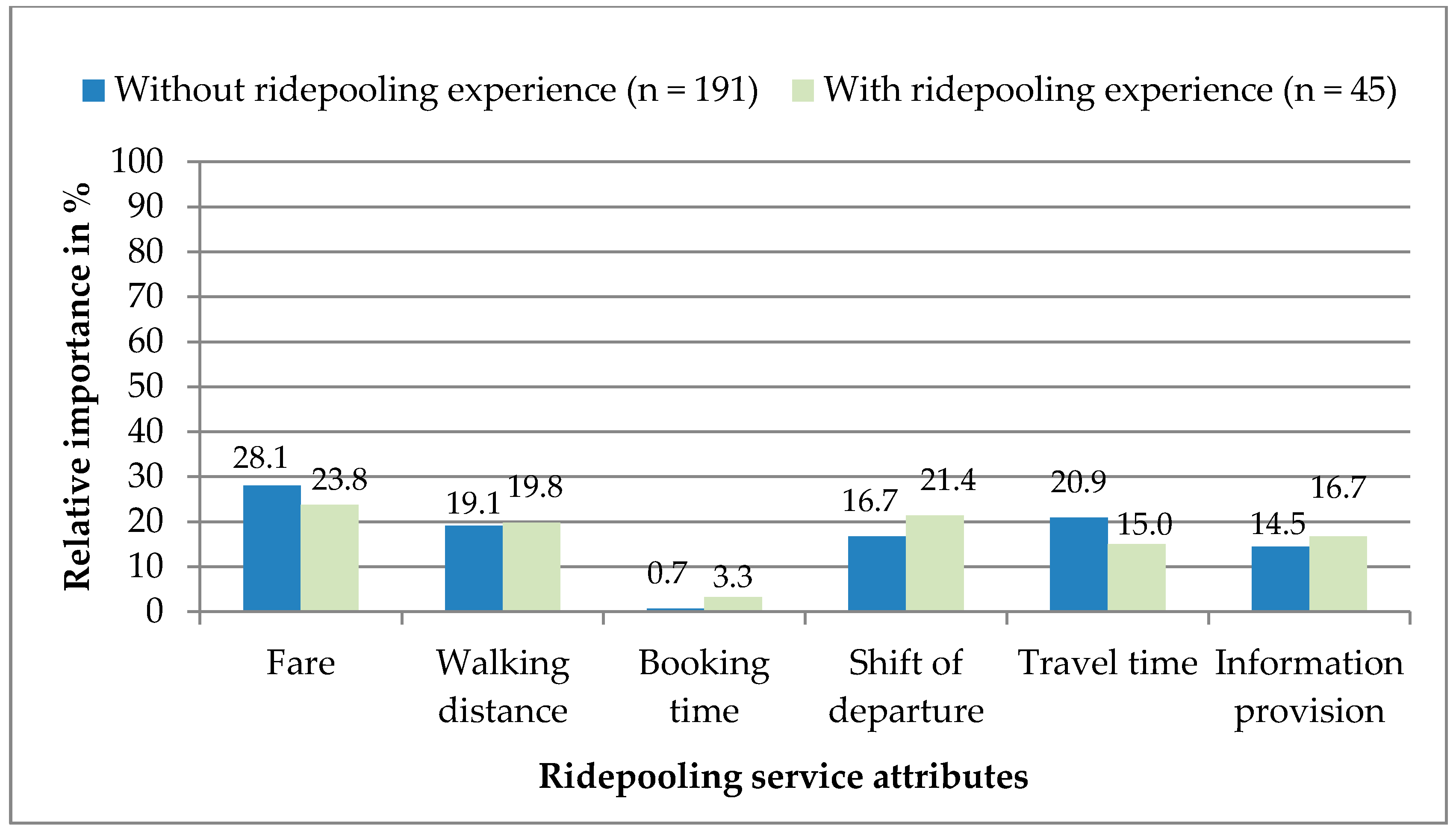
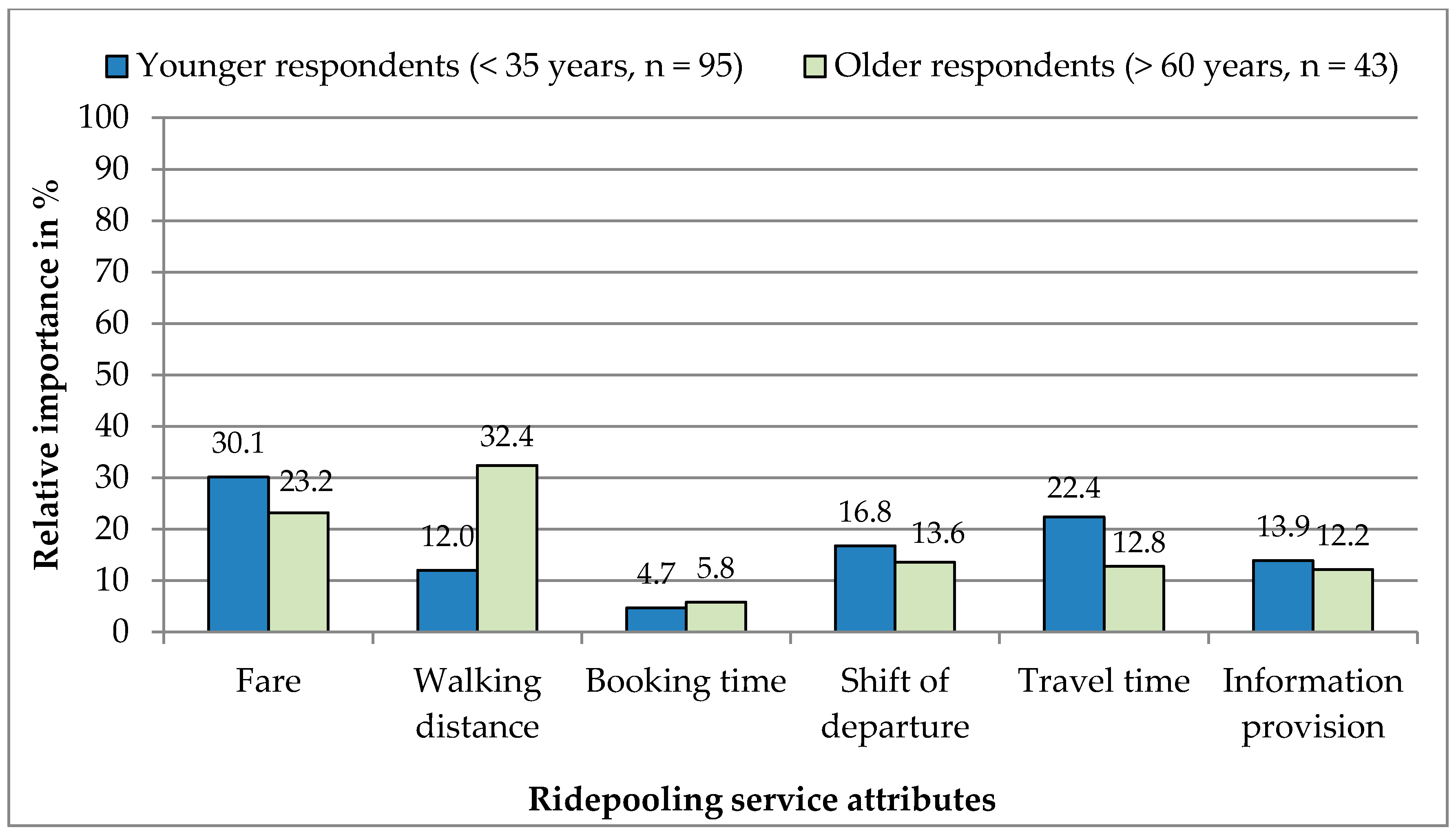
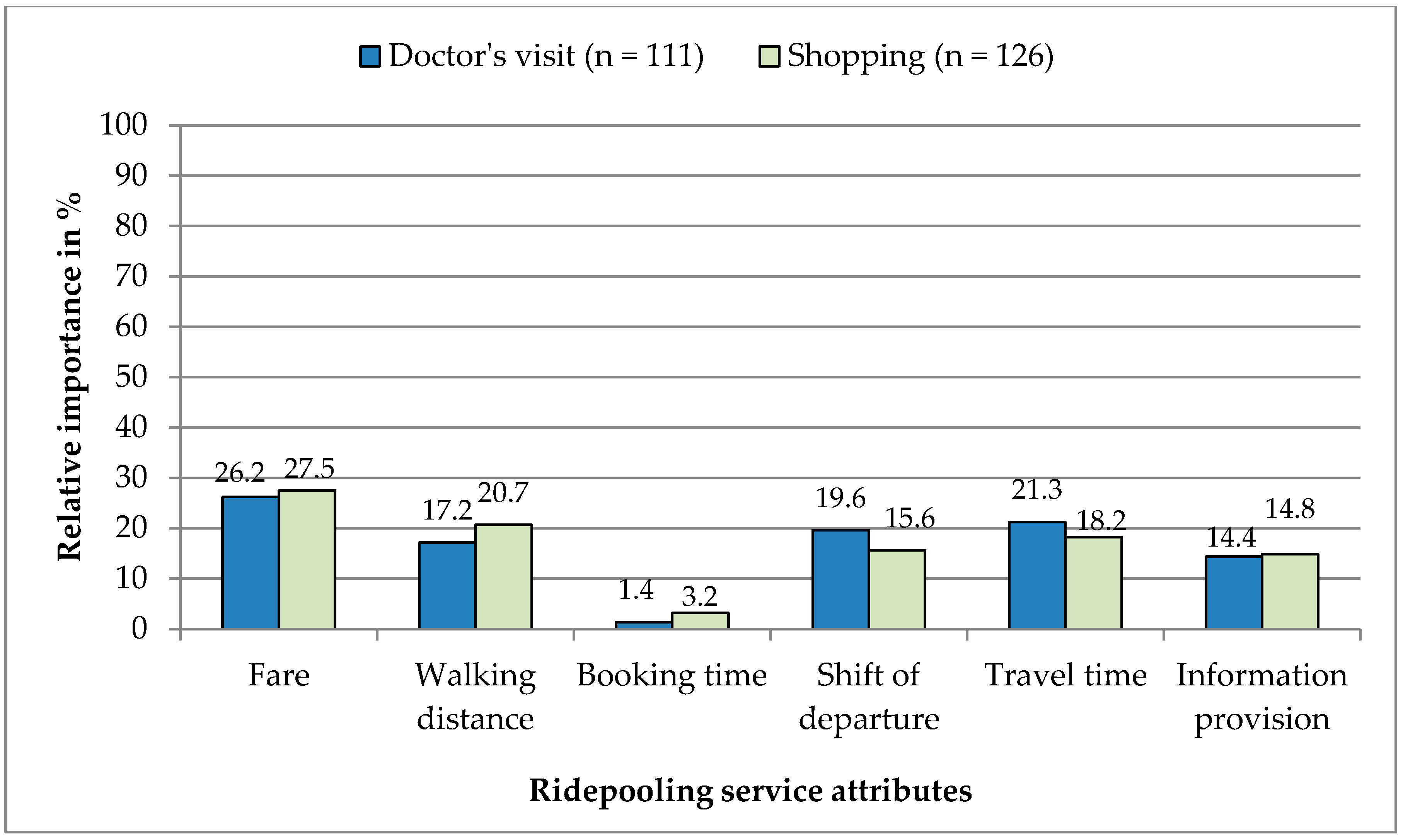
| Attributes | Levels | |||
|---|---|---|---|---|
| Level 1 | Level 2 | Level 3 | Level 4 | |
| Time of booking | 5 min | 10 min | 30 min | |
| Walking distance | 0 m | 300 m | 500 m | |
| Shift of departure time | +0 min | +10 min | +20 min | |
| Travel time | 10 min | 20 min | 30 min | |
| Information provision | None | Little | Much | |
| Fare | 2.50€ | 3.00€ | 3.50€ | 4.00€ |
| Attribute Level | Regression Coefficient | Standard Error | p-Value |
|---|---|---|---|
| Fare_2.50€ | 1.581 | 0.068 | <0.001 ** |
| Fare_3.00€ | 0.979 | 0.072 | <0.001 ** |
| Fare_3.50€ | 0.651 | 0.071 | <0.001 ** |
| Walking distance_0 m | 1.114 | 0.060 | <0.001 ** |
| Walking distance_300 m | 0.700 | 0.062 | <0.001 ** |
| Time of booking_5 min | 0.069 | 0.066 | 0.294 |
| Time of booking_10 min | 0.078 | 0.056 | 0.164 |
| Shift of departure_+0 min | 1.022 | 0.057 | <0.001 ** |
| Shift of departure _+10 min | 0.078 | 0.068 | <0.001 ** |
| Travel time_10 min | 1.151 | 0.067 | <0.001 ** |
| Travel time_20 min | 0.604 | 0.056 | <0.001 ** |
| Information_none | −0.925 | 0.063 | <0.001 ** |
| Information_little | −0.402 | 0.057 | <0.001 ** |
| None-of-these (ASC) | −1.645 | 0.099 | <0.001 ** |
© 2018 by the authors. Licensee MDPI, Basel, Switzerland. This article is an open access article distributed under the terms and conditions of the Creative Commons Attribution (CC BY) license (http://creativecommons.org/licenses/by/4.0/).
Share and Cite
König, A.; Bonus, T.; Grippenkoven, J. Analyzing Urban Residents’ Appraisal of Ridepooling Service Attributes with Conjoint Analysis. Sustainability 2018, 10, 3711. https://doi.org/10.3390/su10103711
König A, Bonus T, Grippenkoven J. Analyzing Urban Residents’ Appraisal of Ridepooling Service Attributes with Conjoint Analysis. Sustainability. 2018; 10(10):3711. https://doi.org/10.3390/su10103711
Chicago/Turabian StyleKönig, Alexandra, Tabea Bonus, and Jan Grippenkoven. 2018. "Analyzing Urban Residents’ Appraisal of Ridepooling Service Attributes with Conjoint Analysis" Sustainability 10, no. 10: 3711. https://doi.org/10.3390/su10103711
APA StyleKönig, A., Bonus, T., & Grippenkoven, J. (2018). Analyzing Urban Residents’ Appraisal of Ridepooling Service Attributes with Conjoint Analysis. Sustainability, 10(10), 3711. https://doi.org/10.3390/su10103711





